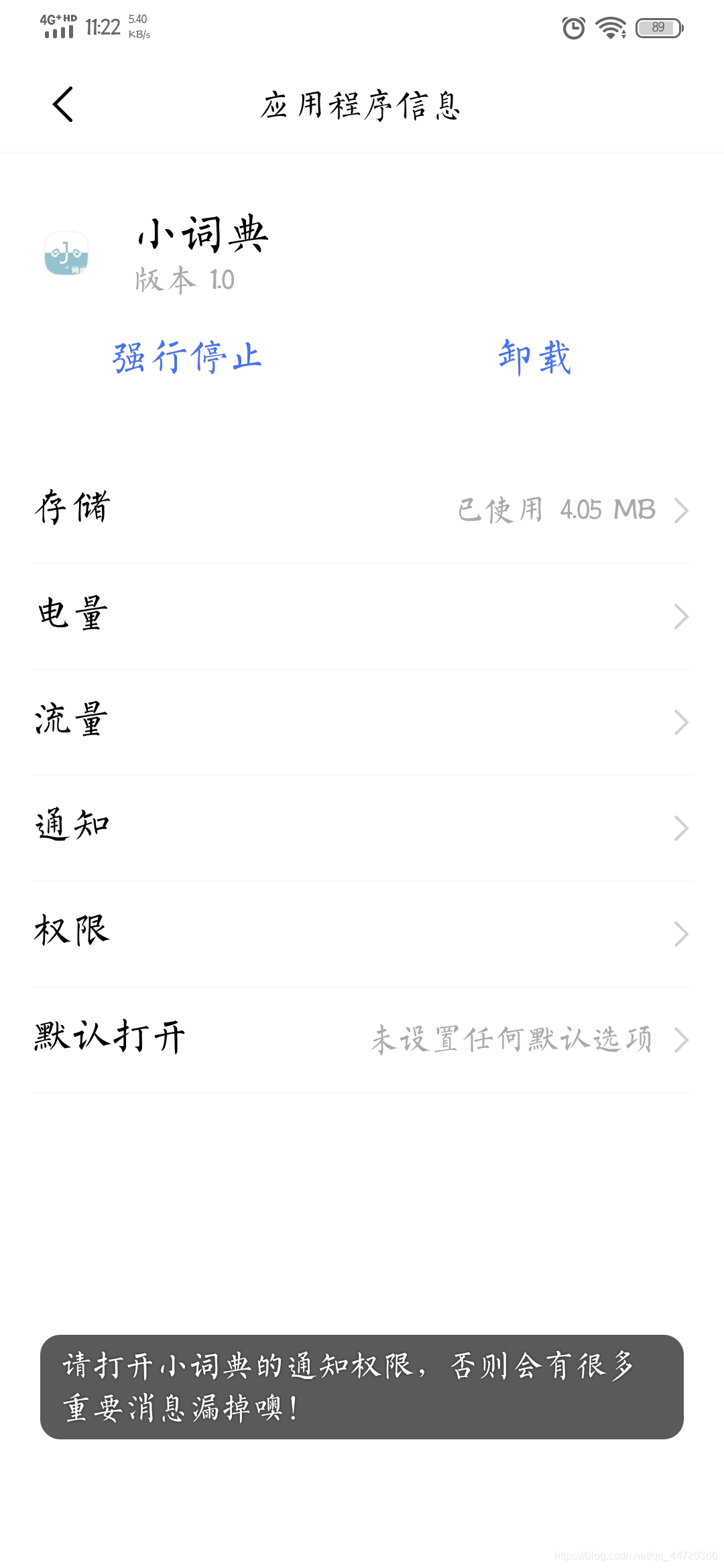| Android 8.0+通知栏(Notification)适配详解,判断通知权限是否打开,并跳转至通知管理页面 | 您所在的位置:网站首页 › 华为手机怎样开启通知权限 › Android 8.0+通知栏(Notification)适配详解,判断通知权限是否打开,并跳转至通知管理页面 |
Android 8.0+通知栏(Notification)适配详解,判断通知权限是否打开,并跳转至通知管理页面
|
前不久因为API26(Android 8.0)以上的设备无法显示通知栏,所以网上查阅了比较多了资料,得出结论,API26以后引入了通知渠道这么个东西,然后就写了一篇问题对应的博文:Android 8.0通知栏(Notification)适配,在模拟上是完美运行,可是当我前两天安装到真机上测试时,咦?怎么又无效了?然后我就想着,是不是通知权限没打开?因为模拟器上很多权限的控制和真机上差别很大,我打开设置一看,还真是!那么本文就接着Android 8.0通知栏(Notification)适配作一个补充。 文章目录 Android 10 真机测试效果:判断通知权限是否打开一行代码判断areNotificationsEnabled() 的源码(可忽略) 跳转到通知管理页面方法逻辑: 补充方法逻辑 Android 10 真机测试效果:
我们要打开通知 管理页面 第一步当然是判断 通知权限是否打开了? ,打开了我们就不需要跳转到通知管理页面了,没打开我们才进行跳转。 这里我们用NotificationManagerCompat提供的 .areNotificationsEnabled() 方法来判断通知权限是否打开,返回的是boolean值 NotificationManagerCompat.from(this).areNotificationsEnabled()注意:这个方法只适用于API19(Android 4.4)以上,API19以下会直接返回true,当然我们不是特殊开发也可以忽略了,毕竟现在市场上低于 Android4.4 的手机恐怕不好找,而且貌似Android4.4以下的对权限这块也没有太严格~ areNotificationsEnabled() 的源码(可忽略)我们来看看 areNotificationsEnabled() 的源码,源码可以很清晰明朗地看到,API24以上直接调用 mNotificationManager.areNotificationsEnabled(); 方法,而 API19 -API 23 则是通过反射的方式来获取,API 19 以下就直接返回 true 了 /** * Returns whether notifications from the calling package are not blocked. */ public boolean areNotificationsEnabled() { if (Build.VERSION.SDK_INT >= 24) { return mNotificationManager.areNotificationsEnabled(); } else if (Build.VERSION.SDK_INT >= 19) { AppOpsManager appOps = (AppOpsManager) mContext.getSystemService(Context.APP_OPS_SERVICE); ApplicationInfo appInfo = mContext.getApplicationInfo(); String pkg = mContext.getApplicationContext().getPackageName(); int uid = appInfo.uid; try { Class appOpsClass = Class.forName(AppOpsManager.class.getName()); Method checkOpNoThrowMethod = appOpsClass.getMethod(CHECK_OP_NO_THROW, Integer.TYPE, Integer.TYPE, String.class); Field opPostNotificationValue = appOpsClass.getDeclaredField(OP_POST_NOTIFICATION); int value = (int) opPostNotificationValue.get(Integer.class); return ((int) checkOpNoThrowMethod.invoke(appOps, value, uid, pkg) == AppOpsManager.MODE_ALLOWED); } catch (ClassNotFoundException | NoSuchMethodException | NoSuchFieldException | InvocationTargetException | IllegalAccessException | RuntimeException e) { return true; } } else { return true; } } 跳转到通知管理页面通知权限判断完了当然是要根据判断结果来进行跳转了,上面我们可以知道 NotificationManagerCompat.from(this).areNotificationsEnabled() 是会返回 boolean 值的,true 代表权限已经打开,反之则没有打开,这里我们可以写一个 if 语句根据返回结果来进行判断,这里直接给一个现成的方法吧 方法逻辑: 首先判断 通知权限是否打开如果判断结果是:false(权限没打开),再进行当前手机的 API 判断通过判断API,来调用不同的方法,实现跳转到应用通知设置的页面 private boolean intent(Context context) {//判断应用的通知权限是否打开,返回Boolean值 if (!NotificationManagerCompat.from(context).areNotificationsEnabled()) { Intent localIntent = new Intent(); //判断API,跳转到应用通知管理页面 if (Build.VERSION.SDK_INT >= Build.VERSION_CODES.O) {//8.0及以上 localIntent.addFlags(Intent.FLAG_ACTIVITY_NEW_TASK); localIntent.setAction("android.settings.APPLICATION_DETAILS_SETTINGS"); localIntent.setData(Uri.fromParts("package", context.getPackageName(), null)); } else (android.os.Build.VERSION.SDK_INT >= Build.VERSION_CODES.LOLLIPOP) {//8.0以下 localIntent.setAction("android.settings.APP_NOTIFICATION_SETTINGS"); localIntent.putExtra("app_package", context.getPackageName()); localIntent.putExtra("app_uid", context.getApplicationInfo().uid); } context.startActivity(localIntent); return false; } return true; } 补充这里补充一下 Android 8.0 +的 Notification通知栏消息 的使用,相对于以前也只是加了一个NotificationChannel通知渠道,想要详细看的可以去我前一篇关于通知栏的博客:Android 8.0通知栏(Notification)适配 方法逻辑 首先通过上面的 通知权限判断 方法判断通知权限是否打开打开了的话判断当前手机的API,如果是在 26 (Android 8.0)以上则多实例化一个NotificationChannel对象,并传入一个 ID(用户不可见,要保证id的唯一性) 和一个 Name(用户能看到) ,最后是一个通知的优先级,这里我设置的 高(IMPORTANCE_HIGH)如果API 在 26 以下,我们则直接调用以前使用的方法即可,这样就可以兼容上下API了 public void show(Context context, String title, String msg) { if (intent(context)) { NotificationManager manager = (NotificationManager) context.getSystemService(NOTIFICATION_SERVICE); Notification notification = null; if (Build.VERSION.SDK_INT >= 26) {//API26以上的方法 NotificationChannel channel = new NotificationChannel("id", "name", NotificationManager.IMPORTANCE_HIGH); manager.createNotificationChannel(channel); notification = new Notification.Builder(context, "id") .setContentTitle(title) .setContentText(msg) .setSmallIcon(R.mipmap.img_icon) .build(); } else {//API26以下 notification = new Notification.Builder(context) .setContentTitle(title) .setContentText(msg) .setSmallIcon(R.mipmap.img_icon) .build(); } manager.notify(1, notification); } }如果文章对你还算有点帮助,点个赞吧!
|
【本文地址】
| 今日新闻 |
| 推荐新闻 |
| 专题文章 |

